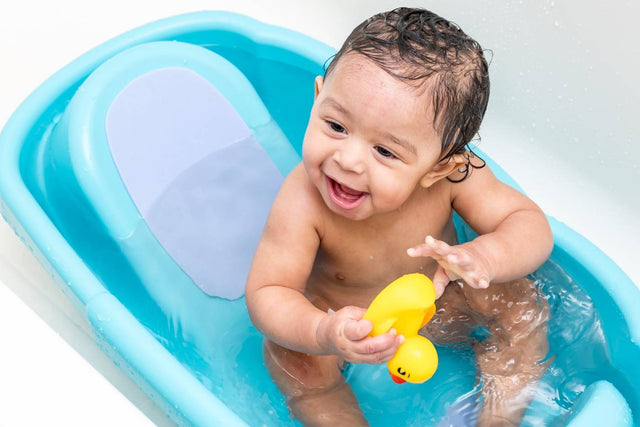7 Bath Safety Tips Parents Should Know

Bathtime isn’t just a necessary ritual during the baby days…it can be a really sweet and fun one! But of course, putting your precious lovebug in a tub of water does come with risks, so it’s crucial that you take some steps to keep them safe.
The primo, most important thing is to never, ever leave your baby unattended in the tub…not even for 3 seconds! That’s all the time it takes for your baby to slide or fall into an unsafe position and inhale water. Most childhood drownings happen at home in the tub (babies have died in just 1 inch of water)…and most bathtub deaths occur in the first year. If you need to run out during bath-time, always scoop your little one up in a towel and take them with you!
During the early months, most parents bathe their babies in a sink. Of course, you have to make sure you never expose your baby to very hot water and protect your wee one from bonking their head on the faucet or getting poked in their little leg by a stopper. There are several slip-resistant liners you can put into the sink, or you could line the bottom with a clean towel to make it less slippery.
When picking out a bathtub for Baby, look for features that keep a baby from sliding down into the water, such as a sling or a sloped, textured surface. And, skip the inflatable tub. Inflatable tubs can be too flimsy to support your baby and slippery, causing your little one to slide into the water. Note: A hand-me-down tub may not be a good option. It’s important that your tub meets the most recent standards. Look for tubs that were made after October 2017, which is the last time the US Consumer Product Safety Commission updated their guidelines.
More Bath Safety Tips
Always keep one hand on Baby. Wet babies are slippery and sometimes wiggle a bit and slide down in the water. Before bath, gather everything you need within arm’s reach, so you don’t have to dart away—even just to the other end of the bathroom—while your little one is soaking.
Skip the bath seat. Though these seats may seem like a smart way to keep babies upright before they have the muscles to sit on their own, they can tip over easily.
Don’t leave water in the bathtub after bath-time ends. This could be a drowning risk for mobile infants or toddlers who find their way into the bathroom to explore.
Make sure your water isn’t too hot. Babies have incredibly sensitive skin that can burn easily. You should be able to comfortably keep your hand under the running water but if you have any doubt, you can use a thermometer to make sure that the temperature doesn’t exceed 100° F. It's also a good idea to set your water heater thermostat to below 120° F to prevent scalding.
Turn off the water before putting your baby in the tub. Leaving it on could lead to the water getting too hot or too deep.
Consider a CPR class. Serious accidents happen every day, and the only way to be prepared…is to be prepared.
Support…yourself. Another overlooked aspect of baby bathtime is support for parents. You’ll be spending a lot of time tub-side. Get a good cushion for your knees or a little stool to sit on when you are next to the tub.